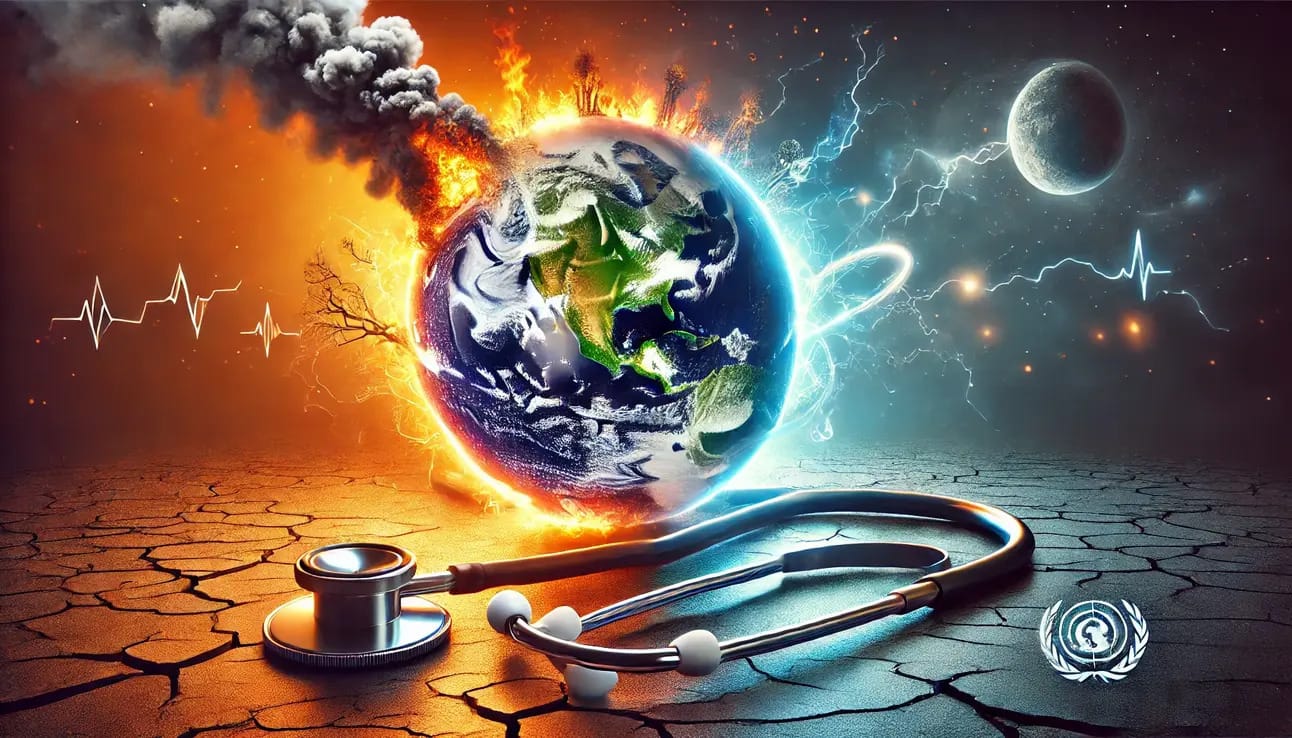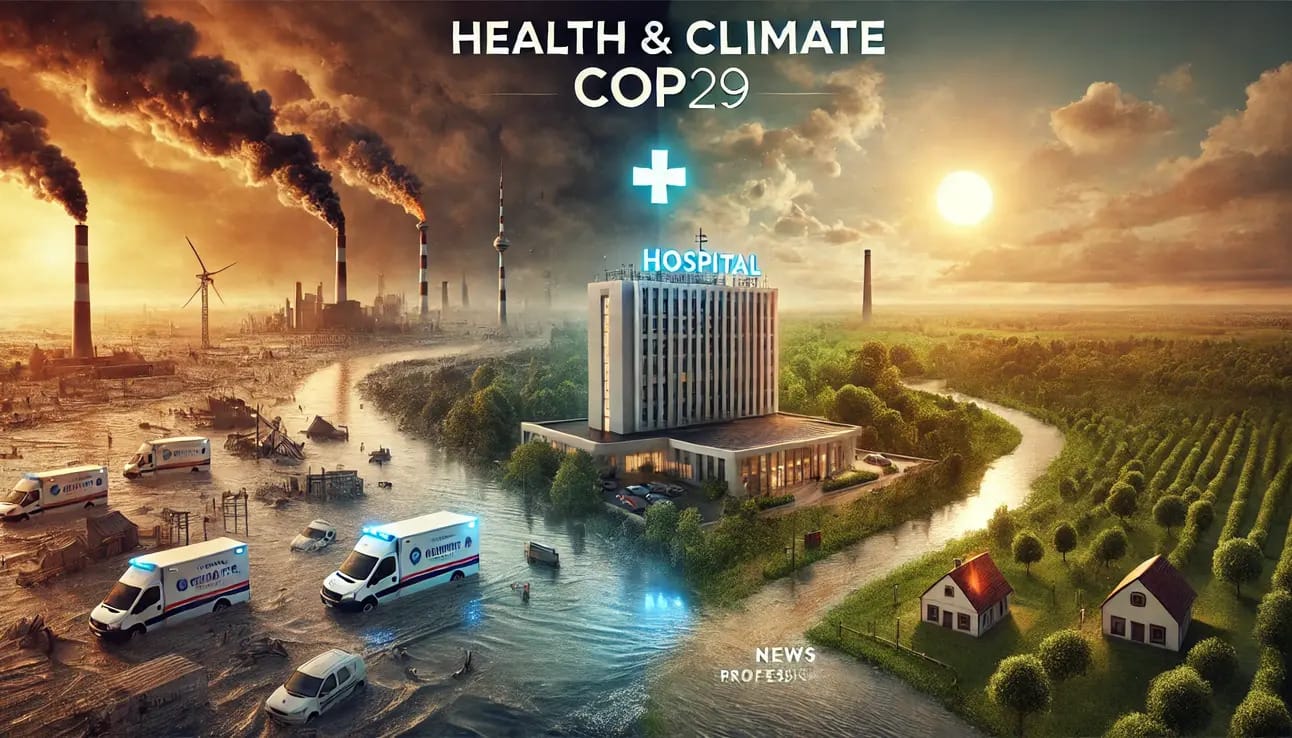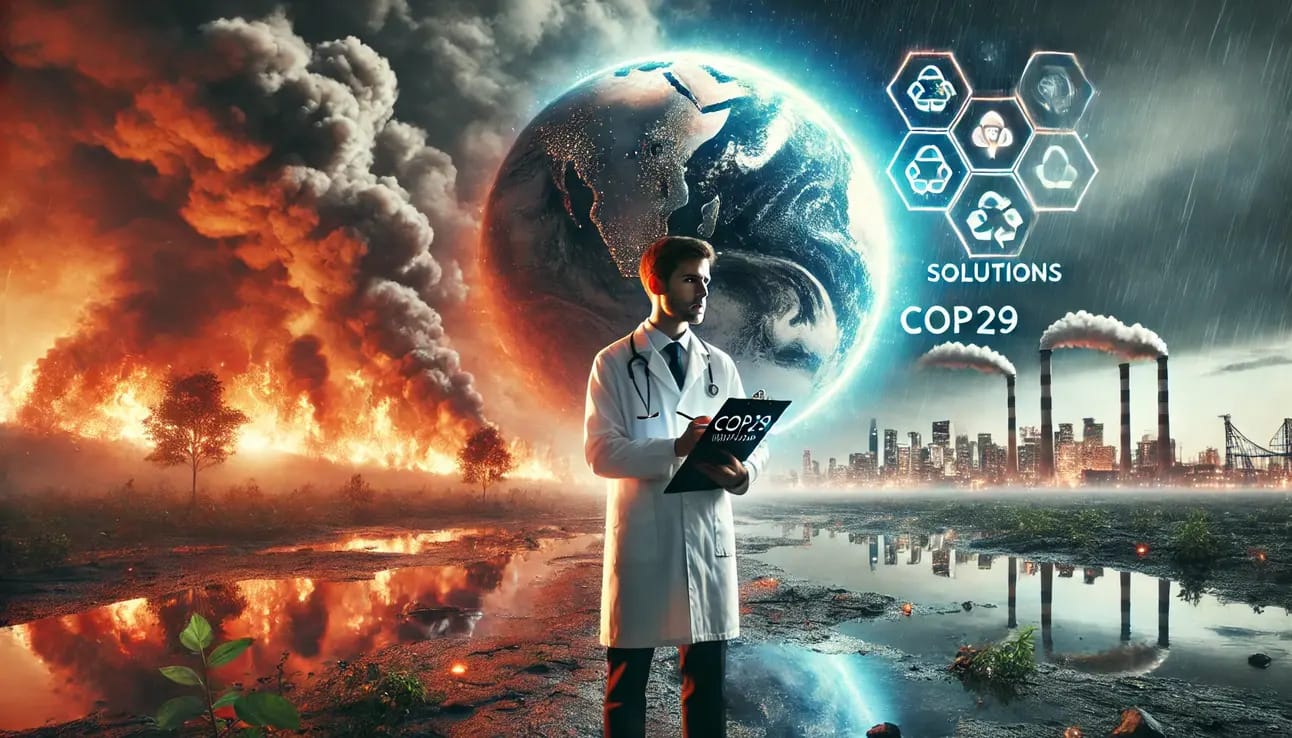- Green Glow
- Posts
- 🌱 Health and Climate: How COP29 Tackled the Human Cost of the Crisis 🌍💉
🌱 Health and Climate: How COP29 Tackled the Human Cost of the Crisis 🌍💉
Explore how COP29 addressed the growing link between climate change and public health. From vulnerable children to global inequalities, learn about the actions proposed to combat the human cost of the climate crisis and protect future generations.
As the climate crisis intensifies, the intersection of health and environmental degradation has emerged as a critical topic of discussion. At COP29 in Baku, leaders, scientists, and health advocates emphasized how climate change is not just an environmental challenge but also a growing public health emergency. The discussions revealed that the warming planet is exacerbating existing health inequalities, disproportionately affecting vulnerable populations such as children, the elderly, and those in low-income countries. This connection between climate and health underscores the urgency of integrating health priorities into climate action plans, a topic that resonated strongly throughout the summit. Here’s a closer look at how COP29 addressed the human cost of the climate crisis and the proposed solutions to mitigate it.
Table of Contents

The Climate Crisis is a Health Crisis
Dr. Maria Neira from the World Health Organization (WHO) set the tone, declaring, “Climate change is making us sick.” She elaborated on how its impacts are widespread, ranging from increased respiratory diseases due to air pollution to waterborne diseases resulting from floods and droughts. The WHO has long warned that climate change could reverse decades of progress in global health, with regions in Africa and South Asia particularly at risk. Moreover, the mental health toll of climate-induced displacement and disasters is becoming more evident, with rising cases of anxiety, depression, and trauma among affected populations. These challenges highlight the need for immediate climate action to protect public health and reduce the strain on healthcare systems worldwide. WHO officials urged governments to view climate policies not just as environmental measures but as investments in global health and human well-being.
Children: The Most Vulnerable Victims
At COP29, UNICEF painted a stark picture of how children are disproportionately affected by the climate crisis. Abheet Solomon from UNICEF explained that children’s fast-growing bodies make them more susceptible to malnutrition, respiratory issues, and waterborne diseases. Climate-induced food shortages exacerbate malnutrition, stunting growth and impairing cognitive development in children, particularly in impoverished regions. Heatwaves and extreme weather events further expose children to physical harm and displacement, compounding the challenges they face. Solomon emphasized that protecting children requires governments to prioritize health and education funding alongside climate adaptation measures. He also called for the inclusion of young voices in decision-making processes, stressing that their futures are at stake in the fight against climate change. The message was clear: safeguarding children’s health must be at the heart of global climate action.
Key Health Risks Linked to Climate Change
The COP29 summit outlined specific health threats tied to climate change, illustrating the multifaceted risks to global populations. For instance, extreme heatwaves are increasingly affecting urban populations, leading to higher rates of heatstroke and cardiovascular complications, especially among vulnerable groups like the elderly and outdoor workers. Air pollution from fossil fuels not only accelerates climate change but also directly causes respiratory and cardiovascular diseases, creating a dual burden on health systems. Furthermore, droughts and floods disrupt access to clean water and food, increasing malnutrition and the prevalence of waterborne diseases such as cholera. Rising temperatures are also expanding the habitats of disease vectors like mosquitoes, leading to increased outbreaks of malaria, dengue, and other vector-borne illnesses. The interconnected nature of these health risks demonstrates the urgency of comprehensive climate strategies that address both mitigation and adaptation to safeguard public health.

Actions Proposed at COP29
The summit brought forth several actionable proposals to address the health impacts of the climate crisis. One major recommendation was the elimination of fossil fuel subsidies, which would not only reduce emissions but also improve air quality, potentially saving millions of lives annually. WHO officials advocated for robust climate-resilient healthcare systems that can withstand the pressures of climate-induced crises, such as heatwaves, floods, and pandemics. This includes integrating renewable energy solutions into healthcare facilities to ensure uninterrupted care during extreme weather events. Additionally, heatwave warning systems and public health campaigns were proposed as cost-effective measures to protect communities from extreme temperatures. Delegates also stressed the importance of clean water and sanitation systems, particularly in regions vulnerable to climate-induced water scarcity. These measures, while ambitious, represent tangible steps toward mitigating the health impacts of climate change, especially for marginalized communities.
The Positive Health Outcomes of Climate Action
Speakers at COP29 emphasized the dual benefits of addressing climate change, highlighting the significant health improvements that could result from sustainable practices. For instance, promoting active modes of transportation like cycling and walking not only reduces carbon emissions but also combats sedentary lifestyles, lowering the prevalence of obesity, diabetes, and cardiovascular diseases. Phasing out fossil fuels would dramatically decrease air pollution, reducing respiratory illnesses and saving millions of lives annually. Similarly, investments in clean energy technologies can create healthier environments while generating economic opportunities in renewable sectors. These co-benefits demonstrate that climate action is not just about avoiding catastrophe but also about building healthier, more resilient societies. As Dr. Neira aptly put it, “The health benefits we unlock by fighting climate change can be enormous, creating a win-win scenario for people and the planet.”
Global Inequalities in Health and Climate
One of the critical messages from COP29 was the unequal burden of the climate crisis, with developing countries bearing the brunt of its health impacts. Low-income nations, which contribute the least to global emissions, are disproportionately affected by extreme weather, food insecurity, and water scarcity. Leaders from countries like Seychelles and the Marshall Islands highlighted how rising sea levels and climate-induced disasters are straining their healthcare systems and economies. They called on wealthier nations to honor their financial commitments and provide the necessary resources to build resilience in vulnerable regions. The lack of equitable access to climate finance not only exacerbates health inequalities but also undermines global efforts to achieve climate justice. Bridging this gap is essential to ensuring that no nation is left behind in addressing the health and environmental challenges posed by climate change.

Conclusion
As COP29 concluded, it became evident that addressing the health impacts of climate change is not just an environmental necessity—it is a moral imperative. Protecting vulnerable populations, particularly children, will require bold policies, sustained funding, and global collaboration. The discussions at the summit highlighted that the health benefits of climate action far outweigh the costs, offering a pathway to a more sustainable and equitable future. However, the true test lies in translating these commitments into action, ensuring that health considerations are prioritized in national and international climate agendas.
The COP29 summit reaffirmed that the climate crisis is inseparably linked to public health. By tackling the human cost of the crisis, nations can not only protect their populations but also unlock opportunities for economic growth and social progress. The message from Baku was clear: addressing the health impacts of climate change is central to building a resilient, prosperous future for all. The time for action is now.
FAQs
Why is climate change considered a public health crisis?
Climate change exacerbates health issues by increasing the frequency and severity of heatwaves, air pollution, water scarcity, and the spread of vector-borne diseases like malaria and dengue. These impacts disproportionately affect vulnerable populations, making it a critical public health issue.
How does climate change affect children’s health?
Children are particularly vulnerable to malnutrition, respiratory diseases, and waterborne illnesses exacerbated by climate change. Their developing bodies are less equipped to handle the effects of extreme weather events, food shortages, and poor air quality.
What actions were proposed at COP29 to address health impacts?
Key actions include eliminating fossil fuel subsidies, building climate-resilient healthcare systems, implementing heatwave warning systems, and ensuring access to clean water and sanitation. These measures aim to mitigate the health impacts of climate change while reducing emissions.
What are the health benefits of addressing climate change?
Tackling climate change can lead to cleaner air, reduced respiratory and cardiovascular diseases, and healthier lifestyles through sustainable practices like cycling and walking. It also decreases the risks of climate-induced disasters and their associated health burdens.
You May Also Like
🌱 The Trump Effect: Challenges for Chinese EV Manufacturers in a Changing U.S. Market 🚗⚡
🌱 A Silent Killer: Oil Pollution and Climate-Driven Flooding in South Sudan ⛽☠️
🌱 What a Trump Presidency Means for Global Climate Action: Insights from Climate Experts 🌎📉
🌱 Green Ambitions: How Masdar is Transforming the UAE’s Role in Clean Energy 🌞⚡
🌱 Antarctica Goes Green: The Unseen Effects of Climate Change on Our Coldest Continent 🧊➡️🌿
External Links
Follow Us:
X: https://www.x.com/greenglownews
Youtube: https://www.youtube.com/@greenglownews
Instagram: https://www.instagram.com/greenglownews
Sponsored Links